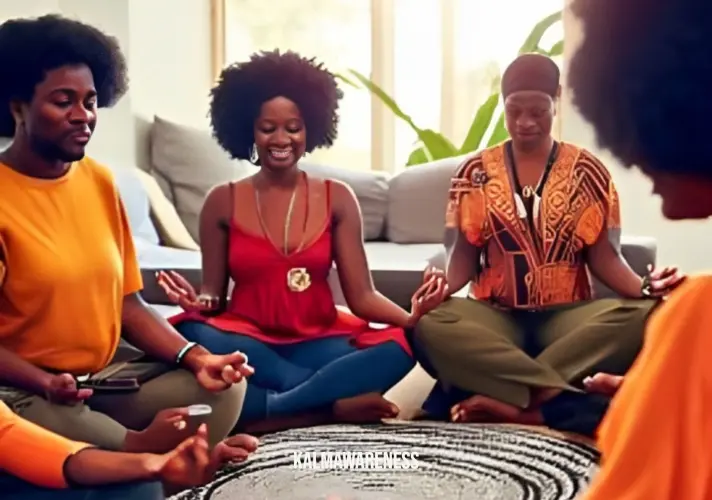Take Three Deep Breaths: Your Path to Tranquility and Mindfulness
The tranquility that can be found at the heart of 3 deep breaths is a powerful force, capable of shaping our lives and freeing us from the chains of anxiety and stress. Amidst the frenzied pace of modern living, these simple breaths can help reconnect us with our inner selves, grounding us in the present moment and ushering in a state of calm.
In this article, we will take a journey into the transformative power of 3 deep breaths, drawing on the wisdom of various breathing techniques and practices from across the globe. We invite you to continue with us on this journey as we unravel the life-changing potential of this simple, yet profound practice.

Why Do We Need to Breathe Deeply?
The answer lies in our biology. We often overlook the importance of breath because it is such an automatic function of our bodies. However, breath is more than just a survival mechanism. It’s an avenue through which we can interact with our minds, influence our mood, and regulate our stress levels. The importance of deep breathing is echoed in the practice of 4-2-6 breathing, which emphasizes longer exhalations for stress reduction.
When we breathe deeply, we tell our nervous system to switch off the ‘fight or flight’ mode and move into a state of calm and relaxation. The result? A decrease in heart rate, lower blood pressure, and a feeling of calm that permeates our entire being.
“Remember, the mind is like a kite and the breath is like the thread. The kite will fly as far as the thread allows it. In the same way, the mind can wander as far as the breath allows it.” – Anonymous
Embracing 3 Deep Breaths
The concept of 3 deep breaths might seem simple, but it’s a practice that has deep roots in meditative traditions worldwide. The first step to harnessing the power of 3 deep breaths is to find a quiet space where you can focus your mind and free yourself from external distractions.
As you draw in your first breath, let it fill your lungs completely, picturing the fresh oxygen reaching every part of your body. The second breath is all about awareness, observing the rising and falling of your chest as you inhale and exhale. With the third breath, you are invited to let go, releasing all tension and stress from your body, leaving you in a state of tranquility.
Much like affectionate breathing, the practice of 3 deep breaths encourages you to approach your breath with kindness and openness. This is not a competition or a goal to be achieved, but a journey to be savored and experienced fully.
The Benefits of 3 Deep Breaths
The beauty of 3 deep breaths lies in its accessibility. It requires no special equipment or location, just a few moments of your time and an open mind. The benefits, however, can be profound.
By practicing 3 deep breaths, you can:
- Gain a greater sense of control over your emotional state, reducing the impact of stress and anxiety on your life.
- Improve your concentration and focus, helping you to perform at your best.
- Connect with your body on a deeper level, promoting a greater understanding of your physical and emotional needs.
- Enhance your overall well-being and quality of life.
This is just the beginning of our exploration into the transformative power of 3 deep breaths. We invite you to continue to the next part of the article where we will delve deeper into various breathing techniques, their application, and how they can help enhance the benefits of 3 deep breaths in your life. Join us as we explore practices like alkaline breathing and cadence breathing that can enrich your 3 deep breaths practice.
Enhancing Your Practice with Various Breathing Techniques
While the practice of 3 deep breaths is powerful in its own right, it can be enhanced by integrating it with other proven breathing techniques. By understanding and experimenting with these practices, you can create a personalized approach that caters to your unique needs and circumstances.
Alkaline Breathing
An interesting technique to enhance your practice is alkaline breathing. This breathing method aims to balance your body’s pH levels by reducing acidity. Notably, stress can contribute to the acidification of your body. So, taking 3 deep breaths in line with alkaline breathing principles may contribute to stress relief both physically and mentally.
Cadence Breathing
Then, there is cadence breathing, a rhythmic breathing practice that can deepen your 3 deep breaths technique. With cadence breathing, you follow a set rhythm for your inhales, pauses, and exhales. This steady rhythm helps you to focus your mind, providing an anchor that can guide you through your practice.
Applying Cadence to Your Breaths
- Begin by sitting comfortably, closing your eyes, and taking a few normal breaths.
- Start your first deep breath, counting to four as you inhale.
- Hold your breath for a count of seven.
- Exhale slowly to a count of eight.
- Repeat this cycle for 3 deep breaths.
Incorporating cadence breathing with your 3 deep breaths practice can enhance your ability to stay present and focused, making each breath more intentional.
Circular Breathing Meditation
The circular breathing meditation is another powerful method that can amplify your breathing practices. This technique visualizes the breath moving in a circle: entering through the nose, filling the lungs, and leaving the body to merge with the energy around you.
“Breathing in, I follow the circle of breath. Breathing out, I become one with the energy of life.” – Anonymous
Combine this visualization with your 3 deep breaths to make your practice not just about stress reduction but also about energy flow and connectivity.
Breathing Apps: Your Companion for Practicing 3 Deep Breaths
In our digital age, there are various tools that can aid and enhance your breathing practices. One such example is a coherent breathing app. Apps like these can guide you through your 3 deep breaths, ensuring you maintain a steady rhythm and providing reminders for daily practice.
Remember, integrating 3 deep breaths into your daily routine is the key to reaping the benefits of this simple yet powerful practice.
With these tools and techniques at your disposal, you can make your breathing practices more effective, helping you reach a state of calm faster and maintain it for longer. As you progress in your journey, remember that every breath is a step towards better mental health and overall well-being.
In the final part of this article, we will explore some practical ways to incorporate 3 deep breaths into your daily routine. We invite you to continue exploring with us as we reveal some powerful techniques to end your day with tranquility and start it with renewed energy.
Practical Ways to Incorporate 3 Deep Breaths into Your Daily Routine
Embedding your 3 deep breaths practice into daily activities can elevate your experience and effectiveness. It provides an immediate stress-relief tool that’s always at your disposal, no matter where you are or what you’re doing. Here are some practical ways to integrate this technique into your routine.
Start Your Day Right
Starting your day with 3 deep breaths can set a positive tone and provide mental clarity. Whether it’s part of your morning meditation, right after you wake up, or even while you’re brushing your teeth, this practice helps clear any lingering drowsiness and equips you with calm energy for the day ahead.
End Your Day with Gratitude and Calm
What could be better than ending your day with a sense of gratitude and tranquility? Consider this end of day meditation, where you reflect on the day’s experiences with a relaxed mind. As part of this practice, integrate your 3 deep breaths to release any residual tension or stress. You might also explore ending the day with gratitude, using your 3 deep breaths as a moment to appreciate the good things that happened during the day.
Raise Your Arms While Breathing
Did you know that raising your arms above your head can help you breathe better? Try this while practicing your 3 deep breaths to open your lungs and deepen your breaths. This small action can make a significant difference to your practice, especially when you feel constricted or anxious.
Involve Your Family
Breathing techniques can be beneficial for everyone in your family, irrespective of their age. It’s a wonderful idea to meditate together as a family and include 3 deep breaths as a starting point. This practice not only instills mindfulness in the younger members but also promotes a sense of peace and unity in the family.
Practice 3 Deep Breaths with Family
- Gather your family in a comfortable and quiet space.
- Guide them to sit comfortably and close their eyes.
- Explain the process of taking 3 deep breaths, emphasizing the importance of inhaling and exhaling deeply.
- Begin the practice together, enjoying the shared experience of calm and connection.
In conclusion, the power of 3 deep breaths lies in its simplicity and accessibility. It requires no equipment, little time, and can be practiced anywhere, anytime. By adopting this practice and integrating it with other techniques as we have discussed in this article, you are on your way to improved mental health, stress reduction, and overall well-being.
As you journey through your path of mindful breathing, remember the quote, “Breath is the power behind all things. I breathe in and know that good things will happen.” – Tao Porchon-Lynch. We hope this article has provided you with valuable insights and methods to deepen your breathing practice and enrich your life.
Advanced Techniques and Tools to Aid Your 3 Deep Breaths Practice
While the concept of 3 deep breaths is simple, various tools and advanced techniques can further enhance its effectiveness. Let’s explore a few.
An App to Guide Your Breathing
In today’s tech-savvy world, it’s no surprise that apps can aid your breathing practices. An excellent app for this purpose is the coherent breathing app, which can guide you through your 3 deep breaths in a rhythmic and soothing manner.
Using a Breathing App
- Download the app to your device.
- Choose the 3 deep breaths exercise.
- Follow the guided prompts.
- Note how your body and mind respond to this regular practice.
Exploring Alkaline Breathing
For an interesting twist to your practice, consider exploring alkaline breathing. This method, which incorporates a specific pattern and rhythm, can complement your 3 deep breaths and offer additional health benefits.
Steps to Alkaline Breathing
- Begin with your usual 3 deep breaths to settle your mind and body.
- Transition to the alkaline breathing pattern.
- Maintain this for a few minutes, then return to 3 deep breaths to close the practice.
Expandable Breathing Ball
An expandable breathing ball is a simple tool that can help visualize your breath. As the ball expands and contracts, it can guide the rhythm of your 3 deep breaths, providing a tactile and visual aid to enhance your mindfulness.
Conscious Connected Breathing
Another advanced breathing technique to explore is conscious connected breathing. This practice involves connecting inhalation and exhalation in a continuous loop, which can be an interesting variation to include after your 3 deep breaths.
As you can see, the simplicity of 3 deep breaths lends itself to being a foundational practice that can be enhanced and deepened by various tools and techniques. As you explore these advanced methods, always return to your 3 deep breaths as a grounding and centering practice.
“Breathing is the first act of life, and the last. Our very life depends on it.” – Joseph Pilates.
Next up, we will be discussing how 3 deep breaths can foster empathy and connectedness, and ways to incorporate it into your social interactions. We will also touch upon some fascinating scientific studies relating to the power of 3 deep breaths. Stay tuned and keep breathing mindfully!
3 Deep Breaths in Relationships: A Tool for Empathy and Connection
The act of mindful breathing does not solely have to be an individual practice; it can also facilitate deeper connections in relationships. A technique known as affectionate breathing allows us to share our practice of 3 deep breaths with our loved ones, creating a space of empathy and connection.
Practicing Affectionate Breathing
- Sit comfortably with a loved one, with your backs touching each other.
- Begin your practice of 3 deep breaths, tuning into each other’s rhythm.
- Feel the connection that arises from this shared practice.
Furthermore, 3 deep breaths can also be incorporated into family practices. For example, family circle meditation can be a powerful way to bond with family members. Starting the session with 3 deep breaths can bring everyone present and ready to share in the experience.

The Science Behind 3 Deep Breaths
The benefits of 3 deep breaths are not just anecdotal; they’re backed by scientific research. One study found that deep, slow breathing can reduce anxiety and promote calmness, while another observed that it can lower blood pressure.
Researching breathing at a rate of 5.5 breaths per minute, which aligns closely with our 3 deep breaths per minute, showed that such a breathing rate could stimulate the parasympathetic nervous system, fostering relaxation and stress reduction.
Key Scientific Findings
- Deep, slow breathing reduces anxiety.
- Lowered blood pressure can result from such practices.
- 5.5 breaths per minute stimulate the relaxation response.
In conclusion, 3 deep breaths is a potent tool for personal and relational wellbeing. It’s a practice that can be expanded upon with advanced techniques and tools, fosters empathy and connection, and is backed by science. It’s simple, it’s accessible, and it’s transformative.
“Just breathe. Ten tiny breaths … Seize them. Feel them. Love them.” – K.A. Tucker
In our next article, we’ll delve deeper into the myriad of ways we can expand our breathwork practice and its profound implications on our physical, mental, and emotional health. See you there, and remember, just take 3 deep breaths.





